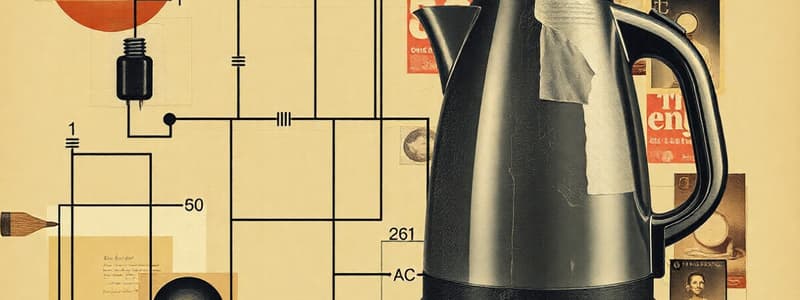Podcast
Questions and Answers
In a series circuit, adding more resistors generally causes the current to:
In a series circuit, adding more resistors generally causes the current to:
- Decrease (correct)
- Increase
- Become zero
- Stay the same
Keeping the voltage constant while adding resistors will result in a constant current in a series circuit.
Keeping the voltage constant while adding resistors will result in a constant current in a series circuit.
False (B)
What is the relationship between resistance and current in a series circuit?
What is the relationship between resistance and current in a series circuit?
As resistance increases, current decreases.
The current measured when four resistors are added in series is expected to be _______ than when only one resistor is used.
The current measured when four resistors are added in series is expected to be _______ than when only one resistor is used.
Match the following circuit components with their functions:
Match the following circuit components with their functions:
What is the power rating of the electric kettle as stated on the information plate?
What is the power rating of the electric kettle as stated on the information plate?
Replacing one of the resistors with a resistor of a higher value will increase the ammeter reading.
Replacing one of the resistors with a resistor of a higher value will increase the ammeter reading.
What is the frequency of the a.c. mains electricity supply?
What is the frequency of the a.c. mains electricity supply?
The maximum power output of the kettle is ___________ watts.
The maximum power output of the kettle is ___________ watts.
Which diagram would show the trace seen on the oscilloscope when the voltmeter in a circuit is replaced with an oscilloscope?
Which diagram would show the trace seen on the oscilloscope when the voltmeter in a circuit is replaced with an oscilloscope?
How many coulombs of charge pass through the heating element in the kettle to boil the water?
How many coulombs of charge pass through the heating element in the kettle to boil the water?
Which instrument is used to measure current in the circuit?
Which instrument is used to measure current in the circuit?
The resistance of a filament lamp increases as the current flowing through it increases.
The resistance of a filament lamp increases as the current flowing through it increases.
The voltage of the kettle's power supply is ___________ volts.
The voltage of the kettle's power supply is ___________ volts.
Match the following electrical terms with their definitions:
Match the following electrical terms with their definitions:
What is the formula for calculating power in an electrical circuit?
What is the formula for calculating power in an electrical circuit?
The resistance of the filament lamp when a current of 0.10 A passes through it is approximately __________ Ω.
The resistance of the filament lamp when a current of 0.10 A passes through it is approximately __________ Ω.
Match each component with its role in a circuit:
Match each component with its role in a circuit:
What does a voltmeter measure?
What does a voltmeter measure?
Explain what happens to the current through a filament lamp when the voltage is increased.
Explain what happens to the current through a filament lamp when the voltage is increased.
The variable __________ in the circuit allows for the adjustment of current and voltage.
The variable __________ in the circuit allows for the adjustment of current and voltage.
Flashcards are hidden until you start studying
Study Notes
Circuit Analysis
- A circuit contains a battery, a resistor, a filament lamp, an ammeter, and a voltmeter.
- The voltmeter is connected in parallel with the filament lamp to measure the potential difference across it.
- When a resistor in a series circuit is replaced with a resistor of higher value, the current through the circuit will decrease.
- The ammeter is connected in series with the circuit to measure the current flowing through it.
- When a voltmeter is replaced with an oscilloscope in the series circuit, the trace on the oscilloscope will show a fluctuating waveform.
- The oscilloscope trace will fluctuate because the source of power is alternating current (AC).
Electric Kettle
- The frequency of the a.c. mains electricity supply is 50 Hz.
- The power of the electric kettle is 2760 W.
- 2400 coulombs of charge pass through the heating element in 200 seconds.
Investigating Current and Resistance
- A student can investigate how the current through a filament lamp affects its resistance by using a variable resistor, voltmeter, and ammeter in a circuit that includes a filament lamp.
- The student should vary the resistance of the variable resistor and record the corresponding readings on the ammeter and voltmeter.
- The potential difference across the lamp can be measured using the voltmeter.
- The current flowing through the lamp can be measured using the ammeter.
- The resistance of the filament lamp can be calculated using Ohm's Law: Resistance = Potential difference / Current.
- By plotting a graph of potential difference against current, the student can determine the resistance of the filament lamp at different currents.
Resistance and Current
- The resistance of the filament lamp increases as the current through it increases.
Series Circuit
- A student uses a series circuit to investigate how the number of resistors affects the current.
- The student keeps the potential difference across the circuit constant.
- By adding more identical resistors in series, the current in the circuit decreases.
- The overall resistance of the circuit increases as more resistors are added in series.
Studying That Suits You
Use AI to generate personalized quizzes and flashcards to suit your learning preferences.




